Washer & Dryer Dimensions: Standard, Stacked, & Compact
Author: Rick Worst | Editor: Omar Alonso
Review & Research: Jen Worst & Chris Miller
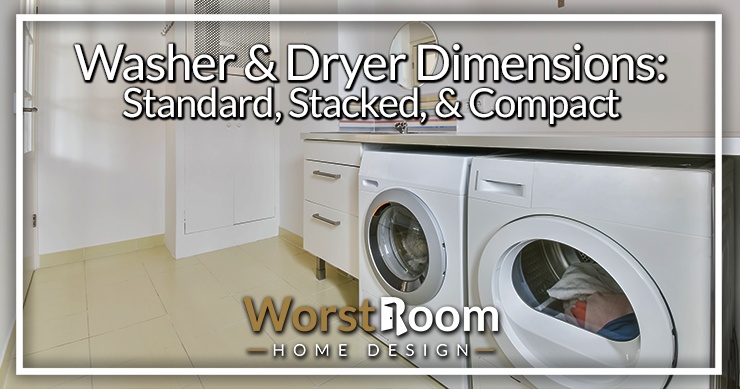
Washer and dryer dimensions tell you the size of the appliance, usually measured in inches. When choosing a unit, you need to know the specifications to see if they fit in the designated laundry space. Knowing the correct dimensions saves time and money when you buy appliances.
Why Washer & Dryer Dimensions Matter
Washer and dryer dimensions matter because they tell you the exact size. This information will help you assess if they fit in the ideal space.
Appliances that exceed the available space stick out from the area or have gaps around the edges. You might be unable to connect them to the power. Washers also need a water connection as well as drainage options and dryers need vents. You might have trouble opening the door and accessing the appliance interior, depending on the location.
If the appliance dimensions are smaller than the space, they may not meet your capacity needs. They might look out of place in your kitchen or laundry room, causing gaps where you can lose items.
The specific dimensions affect the functionality of the appliances. A larger washer has more capacity, allowing you to wash many clothes simultaneously. A smaller washer will take up less space, but you must wash more loads. Remember that a big dryer can handle larger loads, while a smaller dryer is more energy efficient.
Additionally, dimensions are critical if you plan to stack the washer and dryer. You need to ensure the stacking kit can handle the size.
Standard Washer & Dryer Dimensions
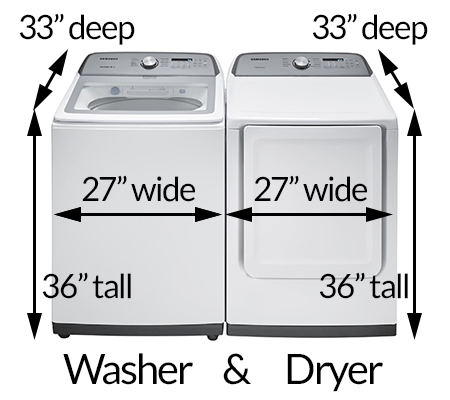
Specific dryer and washer dimensions depend on the model and brand. However, many standard washers have the same width, height, and depth.
- Standard washers are typically 27 inches wide, 33 inches deep, and 36 inches high.
- Standard dryers are usually 27 inches wide, 28 inches deep, and 36 inches high.
Washer and dryer models have different dimensions based on manufacturer, special features, and energy-efficiency. Always check the manufacturer's specifications before a purchase. Double-checking ensures the washer and dryer will fit in your dedicated space.
Remember too that pedestals will add height if you want those. They keep you from needing to bend over as far and will usually have storage drawers in them for extra detergent and other supplies. You can consider washer and dryer pedestal alternatives as well, but they will all add extra height so take that into consideration. A washer height with a pedestal will be significantly taller than without.
Compact Washer & Dryer Dimensions
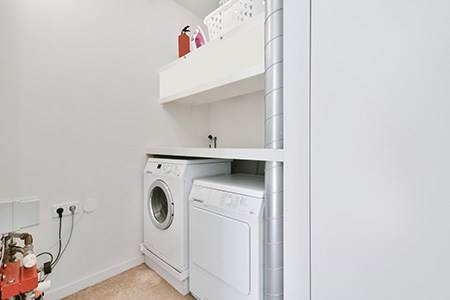
Compact washers and dryers are smaller than standard appliances. Manufacturers design them to save space, so you'll often find them in apartments, condos, or homes with limited space.
The dimensions of a compact washer are usually:
- 24 to 27 inches in width
- 24 to 27 inches in depth
- 33 to 36 inches in height
The dimensions of a compact dryer are similar:
- 24 to 27 inches in width
- 24 to 27 inches in depth
- 33 to 36 inches in height
Due to their small size, you can usually stack compact washers and dryers. You'll save even more space if you install them with a stacking kit. Compact stackable washer and dryer dimensions are typically around 24 inches in width, 24 inches in depth, and 67 inches in height.
You can only stack some types of compact washers and dryers. Ensure the appliances will fit in your designated space and that the stacking kit can handle their weight. There are also washing machine alternatives you can investigate in the meantime, though they require a lot of manual effort.
Stackable Washer & Dryer Dimensions
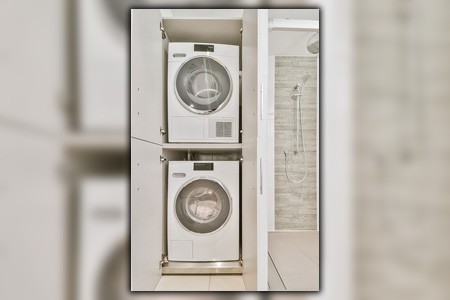
Stackable washer and dryer dimensions refer to the size of a standard washing machine and dryer once you stack them on top of each other. They save horizontal space because you don't need to put them side by side. However, you should ensure you have enough vertical space to suit their combined height.
The dimensions will be different depending on the model and brand. Overall, they have a width of 27 inches, a depth of 28 inches, and a total height of 74 inches. Each appliance can vary, so check the dimensions before you buy them and attempt to stack them.
Check the manufacturer's specifications before purchasing stacked appliances. You want to ensure it includes a stacking kit or tells you what kit to purchase separately.
Extra Large Washer & Dryer Dimensions
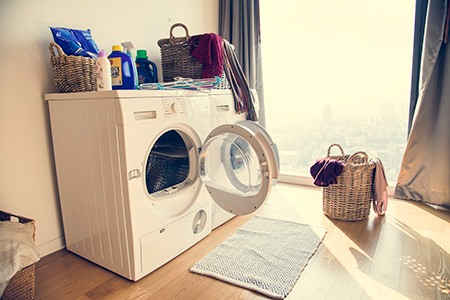
Many people love how compact washers and dryers save space, but others want something bigger to accommodate extra large loads. They also give you more space on top to separate your clothes colors before drying or washing.
These appliances are ideal for larger families or commercial use in laundromats or hotels. They have a larger capacity than standard washers and dryers and can handle many items in a single load.
The dimensions of extra-large washers vary based on the model. They generally have a width of 27 to 30 inches, a depth of 30 to 34 inches, and a height of 40 to 44 inches.
Extra-large dryers have similar dimensions of a 27 inch to 30 inch width, 30 inch to 34 inch depth, and 42 inch to 46 inch height.
Several brands have extra-large appliances, including:
- LG
- Maytag
- Speed Queen
- Whirlpool
Due to their extensive size, you can't stack some extra large washers and dryers. Keep that in mind if you have limited space. You can look for options that include a stacking kit or buy a smaller, stackable option and run more loads.
A Word About Top-Loading vs. Front-Loading Washers

Top-loading and front-loading washers have different dimensions based on the model and brand. Top-loading washers are taller and you can access the clothes from a comfortable standing position. They also have a larger capacity than front-loading washers because you can pile the clothes inside the machine.
Top-loading washers often have a height of 42 to 44 inches, a width of 27 to 30 inches, and a depth of 28 to 34 inches. These appliances have a vertical drum with the door on top of the machine. You'll load and unload clothes from the top, so you can stand while you do laundry.
Front-loading washers are usually 38 to 42 inches tall, 27 to 30 inches wide, and 28 to 34 inches deep. These appliances have a horizontal drum, meaning that the door is on the front of the machine. You'll load and unload the clothes from the front, so you'll have to bend or crouch down to access them all. This posture can hurt your lower back, so choose carefully.
In addition to posture, consider the machine's capacity. Top-loading washers have a larger capacity than front-loading washers. You can wash more items per load, making them a great choice for larger households or people who prefer to wash fewer loads of laundry.
What To Consider When Shopping for a New Washer & Dryer
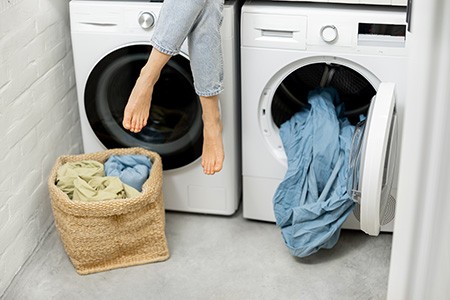
When you intend to purchase a washer and dryer, consider several factors to select the right unit for your purposes.
Determine Your Needs - Consider the size of your household, the types of fabrics you typically wash, and how often you want to do laundry. You can also look for special features, like steam cleaning or energy efficiency.
Measure the Space - Choose the location where you plan to put the new washer and dryer. Make a note of any size restrictions or delivery concerns. Think about the differences between a top-loading and front-loading washer and how it will open in the designated space.
Compare Features & Prices - Look for models that have the features you need, and shop around to check prices from different retailers.
Consider Your Style - Determine the color and aesthetic you want your appliances to fit. There are many colors and finishes for these appliances, so you're not stuck with white.
Read Customer Reviews - Get a sense of the pros and cons of different models and see how well they hold up over time.
Look for Models With Energy Star Ratings - This indicates they meet energy efficiency standards set by the government.
Check for Sales or Discounts - Consider buying during off-peak periods to get the best deal.
Seek a Respectable Warranty - Find a manufacturer that offers a quality warranty. Understand what it covers and how long it lasts.
Sizes of Standard Washing Machines Explained
Always verify the standard washing machine sizes before making a purchase, including the dryer. The measurements tell you how much space the appliances will take up in your home. You can plan the most efficient laundry area when you have the exact specifications for your preferred make and model.
Measure the area where you plan to place the appliances before you make a purchase. You'll get a chance to imagine the ideal-sized appliances in the location.
Considering the washer and dryer dimensions of the models you have your eyes on helps you determine the capacity of each. There are many quality brands, ensuring you buy the best unit for your intended energy use and laundry schedule.



